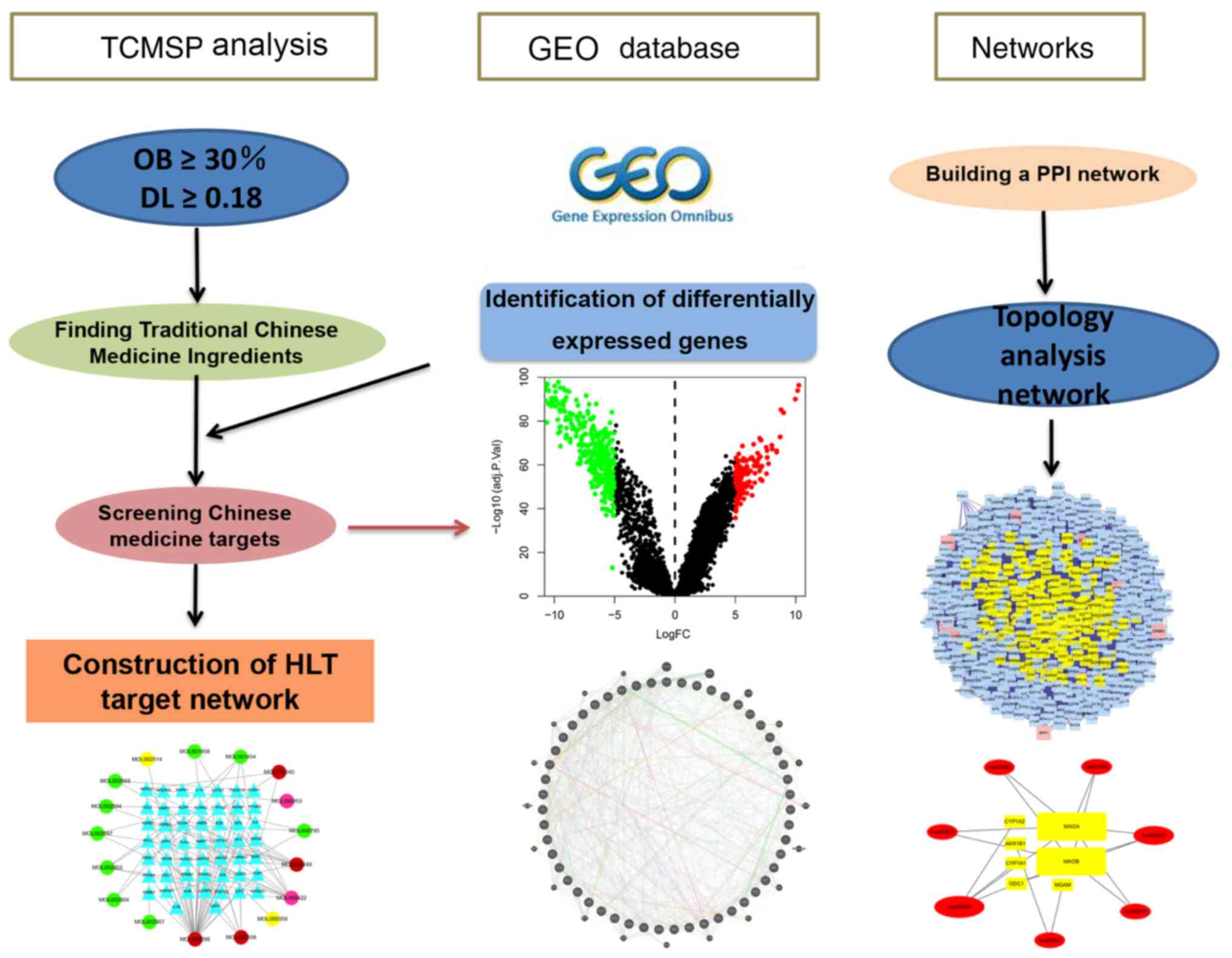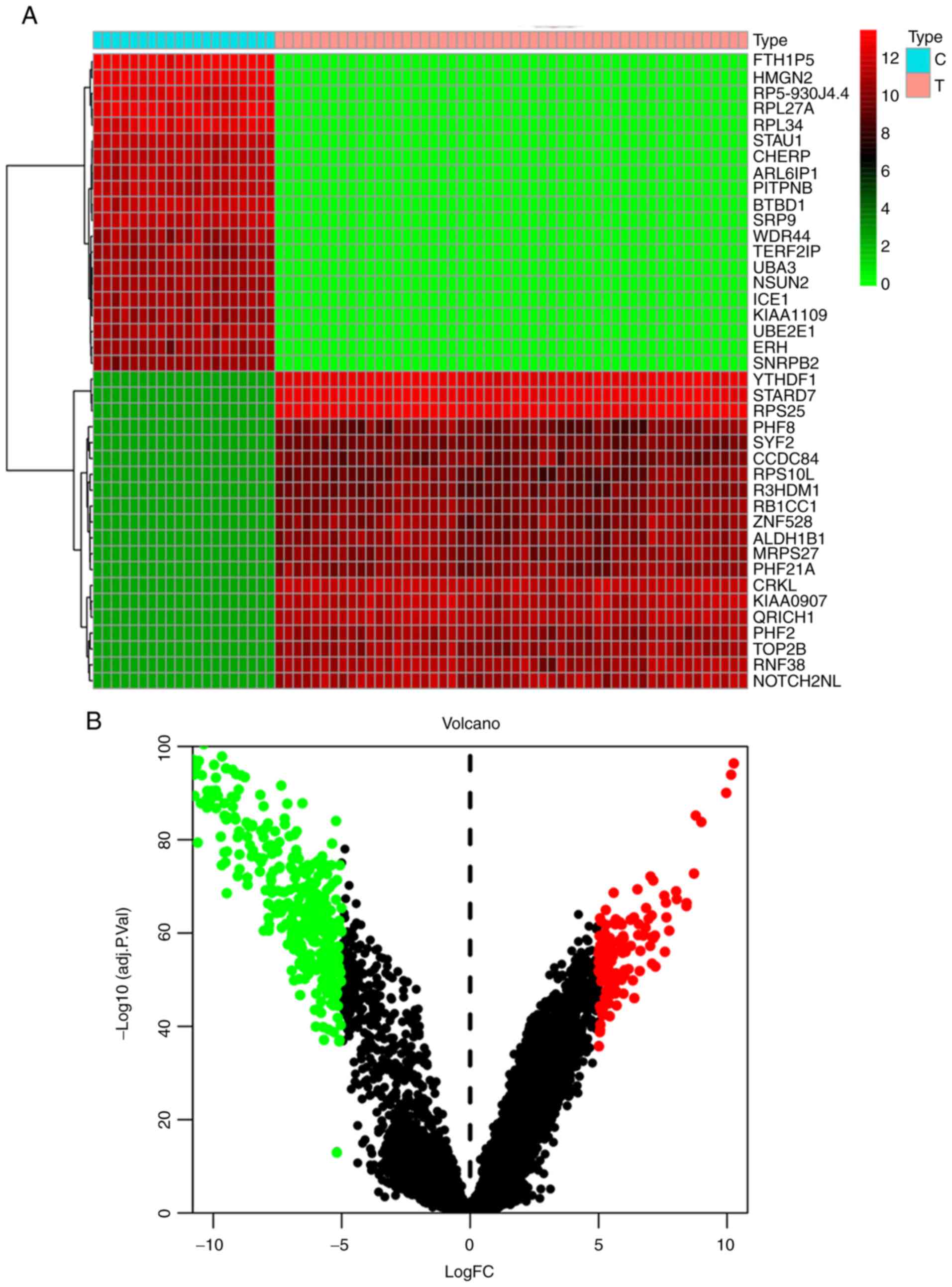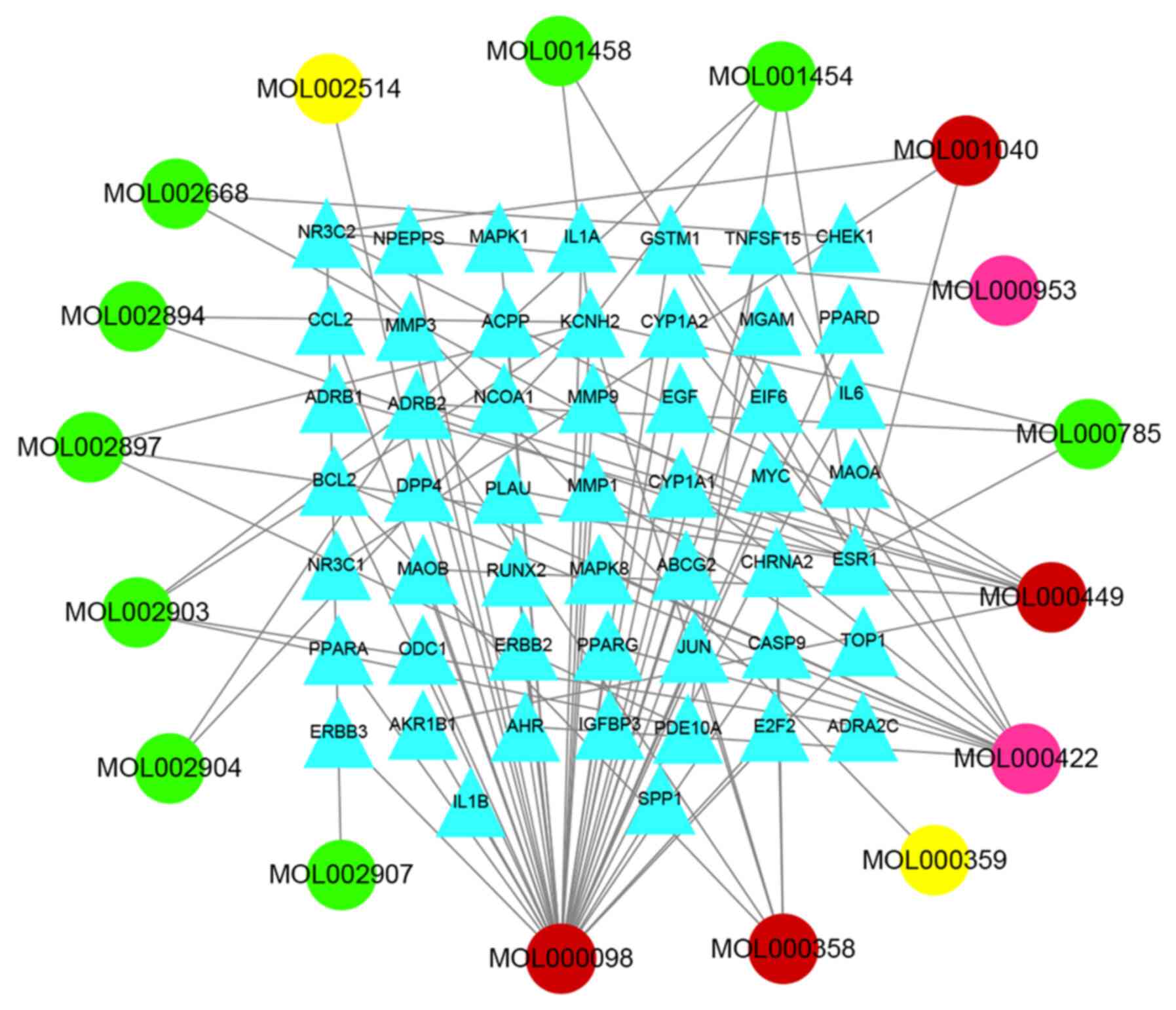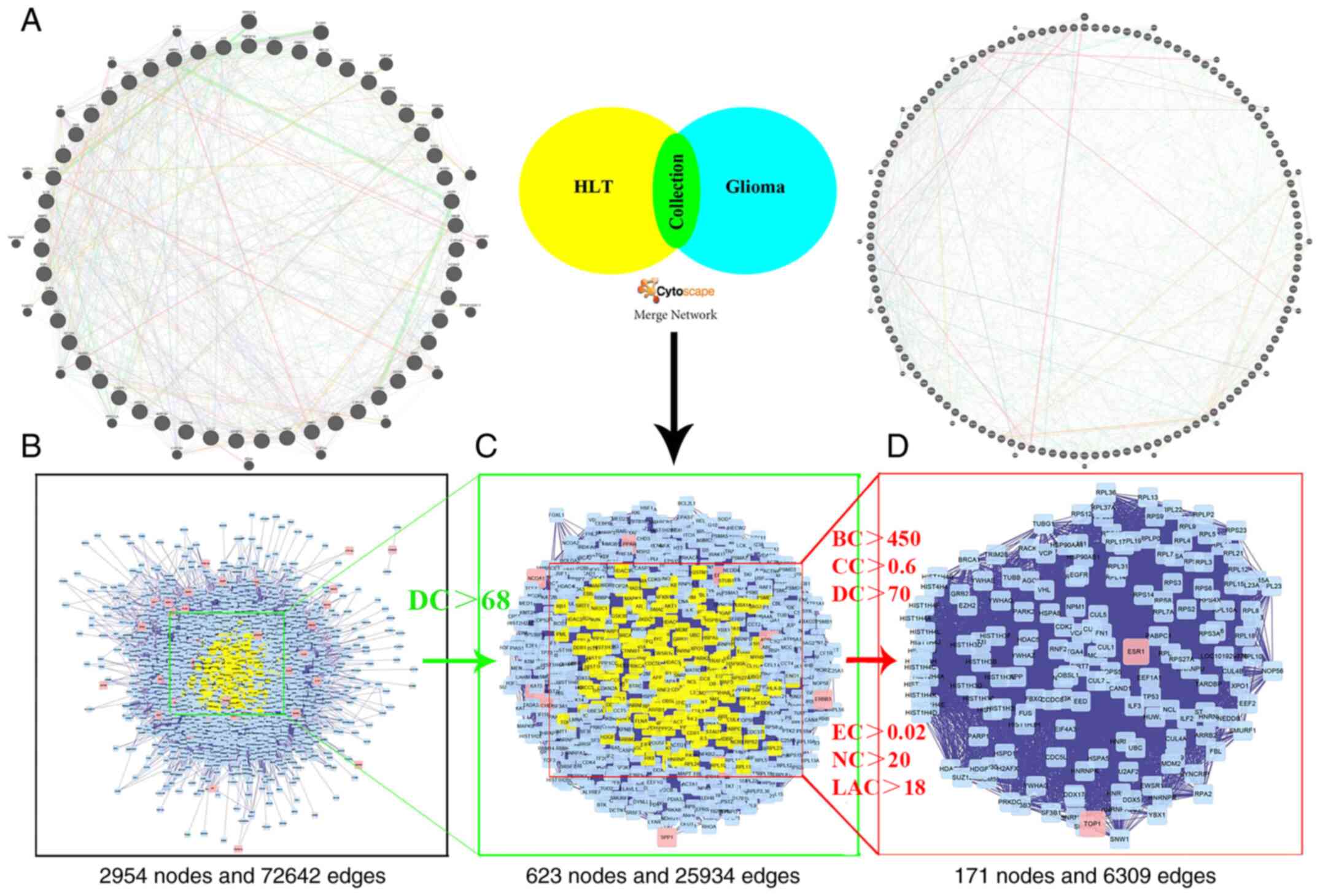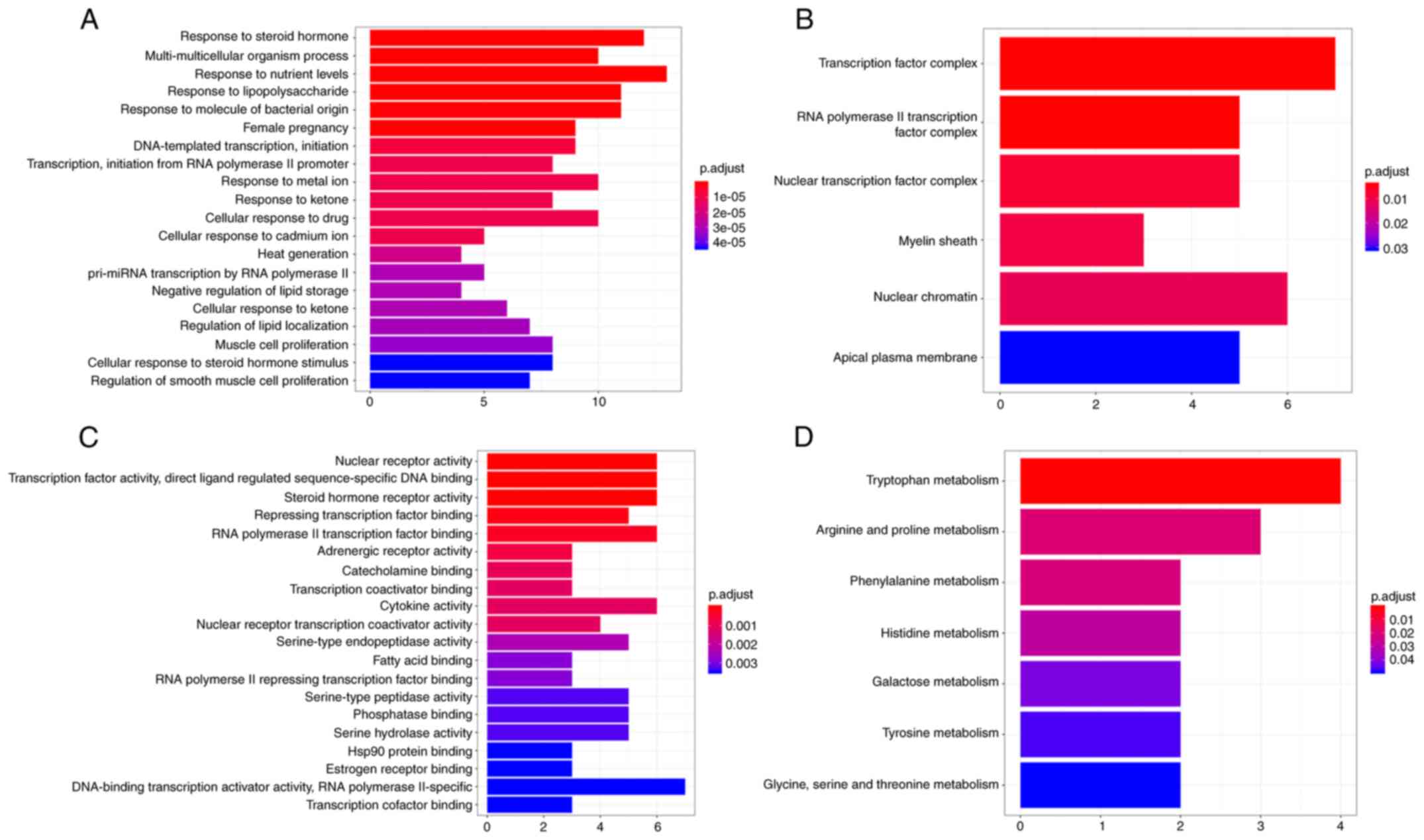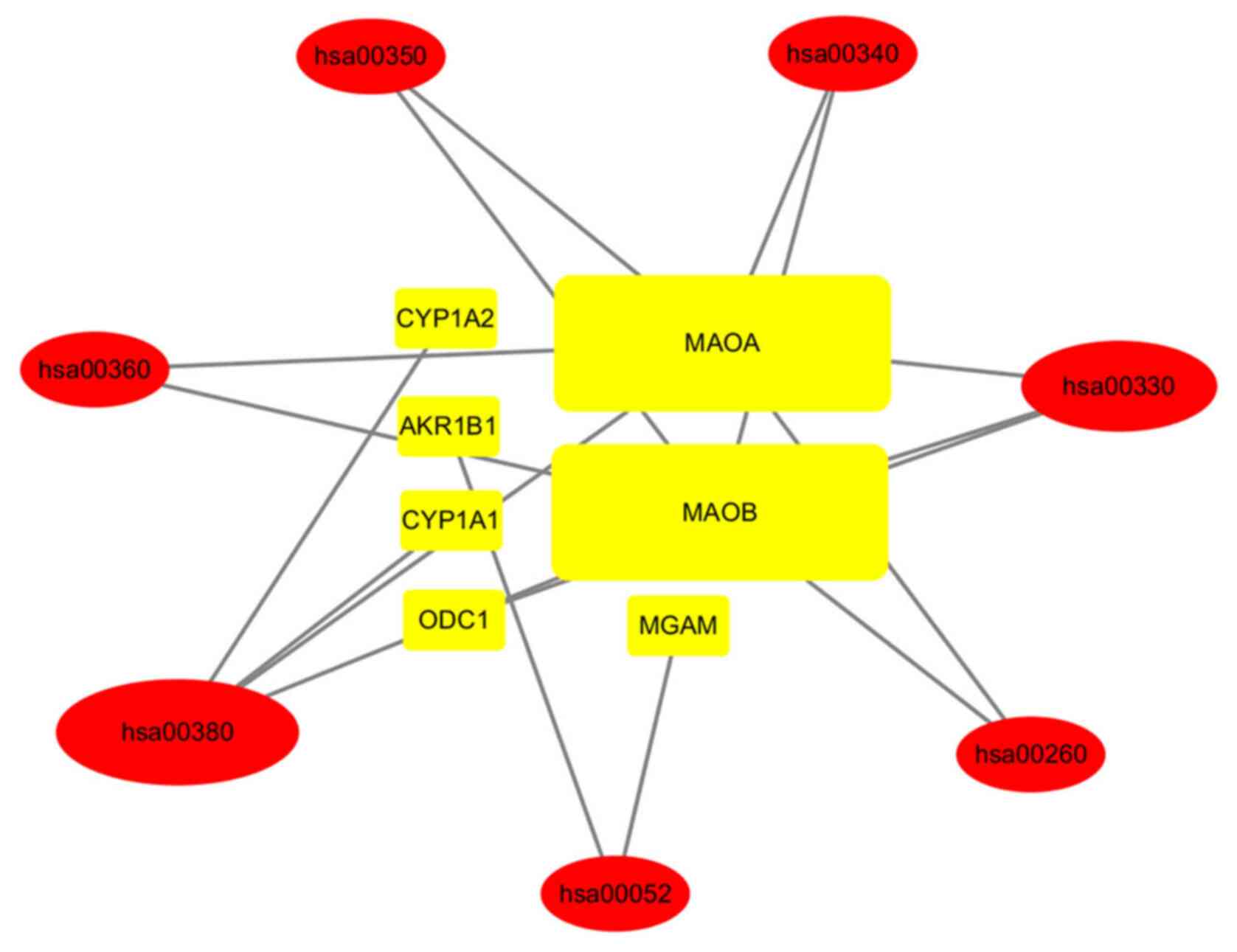|
1
|
Wen PY and Kesari S: Malignant gliomas in
adults. N Engl J Med. 359:492–507. 2008. View Article : Google Scholar : PubMed/NCBI
|
|
2
|
Ostrom QT, Gittleman H, Farah P, Ondracek
A, Chen Y, Wolinsky Y, Stroup NE, Kruchko C and Barnholtz-Sloan JS:
CBTRUS statistical report: Primary brain and central nervous system
tumors diagnosed in the United States in 2006–2010. Neuro Oncol. 15
(Suppl 2):ii1–ii56. 2013. View Article : Google Scholar : PubMed/NCBI
|
|
3
|
Liu BL, Cheng JX, Zhang X and Zhang W:
Controversies concerning the application of brachytherapy in
central nervous system tumors. J Cancer Res Clin Oncol.
136:173–185. 2010. View Article : Google Scholar : PubMed/NCBI
|
|
4
|
Zong G, Wang H, Li J, Xie Y, Bian E and
Zhao B: Inhibition of GPR137 expression reduces the proliferation
and colony formation of malignant glioma cells. Neurol Sci.
35:1707–1714. 2014. View Article : Google Scholar : PubMed/NCBI
|
|
5
|
Baskar R, Lee KA, Yeo R and Yeoh KW:
Cancer and radiation therapy: Current advances and future
directions. Int J Med Sci. 9:193–199. 2012. View Article : Google Scholar : PubMed/NCBI
|
|
6
|
Rivera Vargas T and Apetoh L: Danger
signals: Chemotherapy enhancers? Immunol Rev. 280:175–193. 2017.
View Article : Google Scholar : PubMed/NCBI
|
|
7
|
PDQ Pediatric Treatment Editorial Board, .
Childhood brain stem glioma treatment (PDQ(R)): Patient Version.
PDQ Cancer Information Summaries [Internet]. National Cancer
Institute (US); Bethesda, MD: 2002
|
|
8
|
Tao W, Luo X, Cui B, Liang D, Wang C, Duan
Y, Li X, Zhou S, Zhao M, Li Y, et al: Practice of traditional
Chinese medicine for psycho-behavioral intervention improves
quality of life in cancer patients: A systematic review and
meta-analysis. Oncotarget. 6:39725–39739. 2015. View Article : Google Scholar : PubMed/NCBI
|
|
9
|
Chang WH, Chen CH, Gau RJ, Lin CC, Tsai
CL, Tsai K and Lu FJ: Effect of baicalein on apoptosis of the human
Hep G2 cell line was induced by mitochondrial dysfunction. Planta
Med. 68:302–306. 2002. View Article : Google Scholar : PubMed/NCBI
|
|
10
|
Ma Z, Otsuyama K, Liu S, Abroun S,
Ishikawa H, Tsuyama N, Obata M, Li FJ, Zheng X, Maki Y, et al:
Baicalein, a component of Scutellaria radix from
Huang-lian-jie-du-tang (HLJDT), leads to suppression of
proliferation and induction of apoptosis in human myeloma cells.
Blood. 105:3312–3318. 2005. View Article : Google Scholar : PubMed/NCBI
|
|
11
|
Lee WR, Shen SC, Lin HY, Hou WC, Yang LL
and Chen YC: Wogonin and fisetin induce apoptosis in human
promyeloleukemic cells, accompanied by a decrease of reactive
oxygen species, and activation of caspase 3 and Ca(2+)-dependent
endonuclease. Biochem Pharmacol. 63:225–236. 2002. View Article : Google Scholar : PubMed/NCBI
|
|
12
|
Jia KK, Ding H, Yu HW, Dong TJ, Pan Y and
Kong LD: Huanglian-wendan decoction inhibits NF-κB/NLRP3
inflammasome activation in liver and brain of rats exposed to
chronic unpredictable mild stress. Mediators Inflamm.
2018:30935162018. View Article : Google Scholar : PubMed/NCBI
|
|
13
|
Gu XR, Fang SY, Ren W, Wang HJ, Yang J, Si
N, Bian BL and Zhao HY: Pharmacodynamics of Huanglian Jiedu
decoction in Alzheimer's disease (AD) model rats and effect on
improvement of inflammation microenvironment in brain. Zhongguo
Zhong Yao Za Zhi. 43:3006–3011. 2018.(In Chinese). PubMed/NCBI
|
|
14
|
Hu S, Chen CW, Chen ST, Tsui KH, Tang TK,
Cheng HT, Hwang GS, Yu JW, Li YC, Wang PS and Wang SW: Inhibitory
effect of berberine on interleukin-2 secretion from PHA-treated
lymphocytic Jurkat cells. Int Immunopharmacol. 66:267–273. 2019.
View Article : Google Scholar : PubMed/NCBI
|
|
15
|
Kang JX, Liu J, Wang J, He C and Li FP:
The extract of Huanglian, a medicinal herb, induces cell growth
arrest and apoptosis by upregulation of interferon-beta and
TNF-alpha in human breast cancer cells. Carcinogenesis.
26:1934–1939. 2005. View Article : Google Scholar : PubMed/NCBI
|
|
16
|
Gong B, Kao Y, Zhang C, Zhao H, Sun F and
Gong Z: Exploring the pharmacological mechanism of the herb pair
‘HuangLian-GanJiang’ against colorectal cancer based on network
pharmacology. Evid Based Complement Alternat Med. 2019:27350502019.
View Article : Google Scholar : PubMed/NCBI
|
|
17
|
Dai Y, Sun L and Qiang W: A new strategy
to uncover the anticancer mechanism of Chinese compound formula by
integrating systems pharmacology and bioinformatics. Evid Based
Complement Alternat Med. 2018:67078502018. View Article : Google Scholar : PubMed/NCBI
|
|
18
|
Ru J, Li P, Wang J, Zhou W, Li B, Huang C,
Li P, Guo Z, Tao W, Yang Y, et al: TCMSP: A database of systems
pharmacology for drug discovery from herbal medicines. J
Cheminform. 6:132014. View Article : Google Scholar : PubMed/NCBI
|
|
19
|
Hsu YL, Kuo PL, Tzeng TF, Sung SC, Yen MH,
Lin LT and Lin CC: Huang-lian-jie-du-tang, a traditional Chinese
medicine prescription, induces cell-cycle arrest and apoptosis in
human liver cancer cells in vitro and in vivo. J Gastroenterol
Hepatol. 23:e290–e299. 2008. View Article : Google Scholar : PubMed/NCBI
|
|
20
|
Wang N, Feng Y, Tan HY, Cheung F, Hong M,
Lao L and Nagamatsu T: Inhibition of eukaryotic elongation factor-2
confers to tumor suppression by a herbal formulation
Huanglian-Jiedu decoction in human hepatocellular carcinoma. J
Ethnopharmacol. 164:309–318. 2015. View Article : Google Scholar : PubMed/NCBI
|
|
21
|
Fang H, Wang Y, Yang T, Ga Y, Zhang Y, Liu
R, Zhang W and Zhao J: Bioinformatics analysis for the
antirheumatic effects of Huang-lian-jie-du-tang from a network
perspective. Evid Based Complement Alternat Med. 2013:2453572013.
View Article : Google Scholar : PubMed/NCBI
|
|
22
|
Xu T, Ma C, Fan S, Deng N, Lian Y, Tan L,
Du W, Zhang S, Liu S, Ren B, et al: Systematic understanding of the
mechanism of baicalin against ischemic stroke through a network
pharmacology approach. Evid Based Complement Alternat Med.
2018:25828432018. View Article : Google Scholar : PubMed/NCBI
|
|
23
|
Martin A, Ochagavia ME, Rabasa LC, Miranda
J, Fernandez-de-Cossio J and Bringas R: BisoGenet: A new tool for
gene network building, visualization and analysis. BMC
Bioinformatics. 11:912010. View Article : Google Scholar : PubMed/NCBI
|
|
24
|
Tang Y, Li M, Wang J, Pan Y and Wu FX:
CytoNCA: A cytoscape plugin for centrality analysis and evaluation
of protein interaction networks. Biosystems. 127:67–72. 2015.
View Article : Google Scholar : PubMed/NCBI
|
|
25
|
Barabasi AL, Gulbahce N and Loscalzo J:
Network medicine: A network-based approach to human disease. Nat
Rev Genet. 12:56–68. 2011. View
Article : Google Scholar : PubMed/NCBI
|
|
26
|
Bader GD and Hogue CW: An automated method
for finding molecular complexes in large protein interaction
networks. BMC bioinformatics. 4:22003. View Article : Google Scholar : PubMed/NCBI
|
|
27
|
Huang da W, Sherman BT and Lempicki RA:
Systematic and integrative analysis of large gene lists using DAVID
bioinformatics resources. Nat Protoc. 4:44–57. 2009. View Article : Google Scholar : PubMed/NCBI
|
|
28
|
GLASS Consortium: Glioma through the
looking GLASS: Molecular evolution of diffuse gliomas and the
glioma longitudinal analysis consortium. Neuro Oncol. 20:873–884.
2018. View Article : Google Scholar : PubMed/NCBI
|
|
29
|
Louis DN, Perry A, Reifenberger G, von
Deimling A, Figarella-Branger D, Cavenee WK, Ohgaki H, Wiestler OD,
Kleihues P and Ellison DW: The 2016 world health organization
classification of tumors of the central nervous system: A summary.
Acta Neuropathol. 131:803–820. 2016. View Article : Google Scholar : PubMed/NCBI
|
|
30
|
Szopa W, Burley TA, Kramer-Marek G and
Kaspera W: Diagnostic and therapeutic biomarkers in glioblastoma:
Current status and future perspectives. Biomed Res Int.
2017:80135752017. View Article : Google Scholar : PubMed/NCBI
|
|
31
|
Sugimoto K, Ideguchi M, Kimura T, Kajiwara
K, Imoto H, Sadahiro H, Ishii A, Kawano H, Ikeda E and Suzuki M:
Epithelioid/rhabdoid glioblastoma: A highly aggressive subtype of
glioblastoma. Brain Tumor Pathol. 33:137–146. 2016. View Article : Google Scholar : PubMed/NCBI
|
|
32
|
Farias-Eisner G, Bank AM, Hwang BY,
Appelboom G, Piazza MA, Bruce SS and Sander Connolly E:
Glioblastoma biomarkers from bench to bedside: Advances and
challenges. Br J Neurosurg. 26:189–194. 2012. View Article : Google Scholar : PubMed/NCBI
|
|
33
|
Li Y, Ren Z, Peng Y, Li K, Wang X, Huang
G, Qi S and Liu Y: Classification of glioma based on prognostic
alternative splicing. BMC Med Genomics. 12:1652019. View Article : Google Scholar : PubMed/NCBI
|
|
34
|
Terstappen GC, Schlupen C, Raggiaschi R
and Gaviraghi G: Target deconvolution strategies in drug discovery.
Nat Rev Drug Discov. 6:891–903. 2007. View Article : Google Scholar : PubMed/NCBI
|
|
35
|
Zhang GB, Li QY, Chen QL and Su SB:
Network pharmacology: A new approach for chinese herbal medicine
research. Evid Based Complement Alternat Med.
2013:6214232013.PubMed/NCBI
|
|
36
|
Sang Z, Wang K, Shi J, Liu W, Cheng X, Zhu
G, Wang Y, Zhao Y, Qiao Z, Wu A and Tan Z: The development of
advanced structural framework as multi-target-directed ligands for
the treatment of Alzheimer's disease. Eur J Med Chem.
192:1121802020. View Article : Google Scholar : PubMed/NCBI
|
|
37
|
Wang X, Wu W, Zhang J, Gao L, Zhang L,
Long H, Hou J, Wu W and Guo D: An integrated strategy for holistic
quality identification of Chinese patent medicine: Liuwei dihuang
pills as a case study. Phytochem Anal. Mar 4–2020.(Epub ahead of
print). doi: 10.1002/pca.2927.
|
|
38
|
Zhu N and Hou J: Exploring the mechanism
of action xianlingubao prescription in the treatment of
osteoporosis by network pharmacology. Comput Biol Chem.
85:1072402020. View Article : Google Scholar : PubMed/NCBI
|
|
39
|
Zhou X, Hong Y and Zhan Y: Karacoline,
identified by network pharmacology, reduces degradation of the
extracellular matrix in intervertebral disc degeneration via the
NF-κB signaling pathway. J Pharm Anal. 10:13–22. 2020. View Article : Google Scholar : PubMed/NCBI
|
|
40
|
Gu Y, Chen J and Shen J: Herbal medicines
for ischemic stroke: Combating inflammation as therapeutic targets.
J Neuroimmune Pharmacol. 9:313–339. 2014. View Article : Google Scholar : PubMed/NCBI
|
|
41
|
Chen SJ and Cui MC: Systematic
understanding of the mechanism of salvianolic acid a via
computational target fishing. Molecules. 22:6442017. View Article : Google Scholar
|
|
42
|
Wang S, Wang H and Lu Y: Tianfoshen oral
liquid: A CFDA approved clinical traditional Chinese medicine,
normalizes major cellular pathways disordered during colorectal
carcinogenesis. Oncotarget. 8:14549–14569. 2017. View Article : Google Scholar : PubMed/NCBI
|
|
43
|
Wang X, Yu S, Jia Q, Chen L, Zhong J, Pan
Y, Shen P, Shen Y, Wang S, Wei Z, et al: NiaoDuQing granules
relieve chronic kidney disease symptoms by decreasing renal
fibrosis and anemia. Oncotarget. 8:55920–55937. 2017. View Article : Google Scholar : PubMed/NCBI
|
|
44
|
Xu M, Chen X, Gu Y, Peng T, Yang D, Chang
RC, So KF, Liu K and Shen J: Baicalin can scavenge peroxynitrite
and ameliorate endogenous peroxynitrite-mediated neurotoxicity in
cerebral ischemia-reperfusion injury. J Ethnopharmacol.
150:116–124. 2013. View Article : Google Scholar : PubMed/NCBI
|
|
45
|
Cao Y, Mao X, Sun C, Zheng P, Gao J, Wang
X, Min D, Sun H, Xie N and Cai J: Baicalin attenuates global
cerebral ischemia/reperfusion injury in gerbils via anti-oxidative
and anti-apoptotic pathways. Brain Res Bull. 85:396–402. 2011.
View Article : Google Scholar : PubMed/NCBI
|
|
46
|
Schwartz L, Supuran CT and Alfarouk KO:
The warburg effect and the hallmarks of cancer. Anticancer Agents
Med Chem. 17:164–170. 2017. View Article : Google Scholar : PubMed/NCBI
|
|
47
|
Colomer C, Margalef P, Villanueva A, Vert
A, Pecharroman I, Solé L, González-Farré M, Alonso J, Montagut C,
Martinez-Iniesta M, et al: IKKα kinase regulates the DNA damage
response and drives chemo-resistance in cancer. Mol Cell.
75:669–682.e5. 2019. View Article : Google Scholar : PubMed/NCBI
|
|
48
|
Huang Y, Huang Y, Zhang L, Chang A, Zhao
P, Chai X and Wang J: Identification of crucial genes and
prediction of small molecules for multidrug resistance of Hodgkin's
lymphomas. Cancer Biomark. 23:495–503. 2018. View Article : Google Scholar : PubMed/NCBI
|
|
49
|
Hensley CT, Wasti AT and DeBerardinis RJ:
Glutamine and cancer: Cell biology, physiology, and clinical
opportunities. J Clin Invest. 123:3678–3684. 2013. View Article : Google Scholar : PubMed/NCBI
|
|
50
|
Srinivasan S, Guha M, Kashina A and
Avadhani NG: Mitochondrial dysfunction and mitochondrial
dynamics-The cancer connection. Biochim Biophys Acta Bioenerg.
1858:602–614. 2017. View Article : Google Scholar : PubMed/NCBI
|
|
51
|
Korf BR: Neurofibromatosis. Handb Clin
Neurol. 111:333–340. 2013. View Article : Google Scholar : PubMed/NCBI
|
|
52
|
Singh A and Zhao K: Treatment of insomnia
with traditional Chinese herbal medicine. Int Rev Neurobiol.
135:97–115. 2017. View Article : Google Scholar : PubMed/NCBI
|















